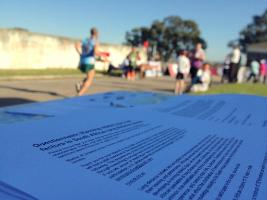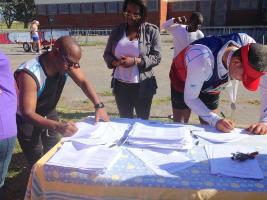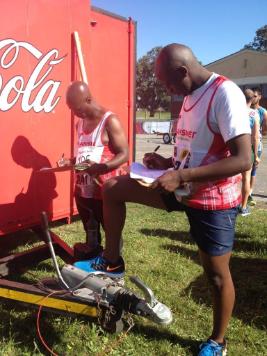Current Research
Featured Research Samantha Parsons' MSc
?
The title of Samantha's research is: "Assessing the fitness level of intellectually disabled children in the Grahamstown region of the Eastern Cape, and subsequently designing, implementing and evaluating the efficacy of an exercise intervention"
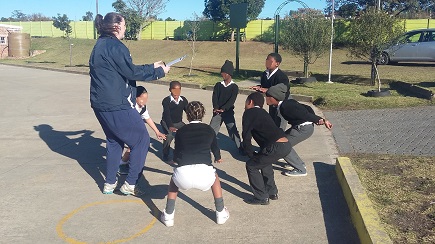
Extensive research has addressed physical fitness as an agent in promoting health and well-being; however, there is little research on this topic for intellectually disabled people and even less relating to the South African context. Intellectually disabled children attending special need schools in disadvantaged communities in the Eastern Cape have lacked the opportunity to participate in structured physical education programs. Implementing a solution to this problem was seen to be a challenge, due to the lack of informative research and available data.
The research was two-fold; firstly, it aimed to identify the physical fitness levels of the intellectually disabled children in the Grahamstown region of the Eastern Cape Province of South Africa (Phase 1); and secondly, it aimed to implement and evaluate the efficacy of an exercise intervention programme on physical fitness in intellectually disabled children (Phase 2).
Phase 1: The descriptive study compared basic anthropometric as well as physical fitness measures from a sample of intellectually disabled participants (n=29) with a comparable sample of typically developed children (n=25). These measures included stature, mass, cardiorespiratory endurance, muscular endurance, strength, body composition, flexibility, balance, agility, speed, power, coordination and reaction time. The results revealed a significant difference (p =0.05) for the anthropometric measures and for eight of the eleven components of physical fitness for the intellectually disabled participants compared to their typically developed peers. Results of the correlation analyses determined significant (p =0.05) relationships between certain health-related and/or skill-related physical fitness components, which were instrumental for selecting measures for Phase 2. The intellectually disabled participants’ low level of physical fitness was in need of improvement, particularly muscular endurance, balance, and power, which were the focus of the exercise intervention in Phase 2 of this research project.
Phase 2: This intervention study was set up as a case-control study (intervention group: n = 16; control group: n = 15), whereby the intervention group was exposed to an 8-week multi-modal exercise intervention training muscular endurance, balance and power. Pre-and post-intervention measures were performed using the same eleven physical fitness tests as in Phase 1. The results showed significant improvements for the intervention group’s performance of muscular endurance (p=0.026) and power (p<0.001), whereas no significant changes were found for balance. Furthermore, the exercise intervention also impacted the overall level of physical fitness, as significant changes were found for cardiorespiratory endurance (p<0.001), strength (p=0.021) and flexibility (p=0.032). In conclusion, the exercise intervention was effective for improving the intellectually disabled participants’ muscular endurance and power but not found effective for balance.
Featured Research Zandile Hoyi's MSc

The title of Zandile's research is: "The effect of rest breaks on return-to-task performance in semi-automated tasks, with varying complexities"
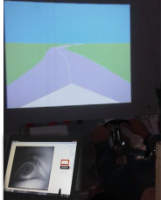
A participant performing the primary tracking task, with eye-tracking device
THE AUTOMATION PREDICAMENT
The design and introduction of automated aids in the cockpit has brought significant changes to the operation of commercial transport aircrafts. The numerous tasks that human pilots are required to perform in order to operate the aircraft safely and effectively have become heavily reliant on the automated system. While automation in the aviation industry is acknowledged to be a useful tool in reducing pilot workload, typically, the role of the pilot shifts from active participation in a process to a task of monitoring the system, with the resumption of control should the automation ‘fail’. Unfortunately, the skills necessary to do so would likely degrade from non-use during the period of being out-of-the-loop (OOTL), since these systems have become ‘addictive’ to the extent that the pilots' flying skilled have regressed to a level upon which following system failures, their ability to handle the aircraft has become doubtful in some cases.
While the majority of the control in the cockpit being shifted to the automation rather than to the pilot, some degree of shared control is still maintained. The proposed control sharing approach is termed Adaptive Automation which is dependent upon situational demands and seeks to find ways of developing this understanding to increase human performance.
A series a questions in response to this kind of approach have arisen. In designing human error out of the cockpit, does this mean that the automation should back up the pilot or should the pilot to back up the automation? What is the pilot's role in such a setting? Contemporary research has shown the advantage of maintaining at least some degree of operator awareness of the various sub-tasks, even if they are performed in a fully automated mode.
This particular project investigated the “attentional demands” for the human operator during interaction with the semi-automated operations of the flight. More specifically, this study was designed to investigate the effects of rest breaks on the return-to-task performance of human operators in a semi-automated setting. Task performance before and after the two types of rest breaks and at two varying workloads (low and high) were compared. The effect of recovery was quantified using changes in performance, physiological, as well subjective sleepiness levels experienced during the tracking task.
The study's participants had to perform a tracking task in a laboratory where they changed from a 30-minute activity to a break and back to the initial task for a further 20 minutes. This task varied in complexity, either entailing a pure tracking task, or a task involving tracking plus a memory plus a rule-based decision making activity. The type of break was either a passive rest or one with active supervision, while the duration of the break was either 2 minutes or 30 minutes long.
With regards to the most appropriate rest break tasks, the results of the study show that the break with active, administrative tasks, allowed the operator to maintain some form of situational awareness by monitoring the automated system, achieved favourable effects of being more alert compared to the passive rest break during which the operator becomes disengaged from the system. In terms of the most appropriate rest break duration, the shorter duration of being out-of-the-loop from controlling the system proved to be more advantageous than the longer out-of-the-loop duration. Considering the workload levels of arousal, the results suggest that the higher workload level is better at maintaining the alertness of operators.
Wickens (1998) put forward that in order to successfully predict recovery under a variety of conditions, human performance needs to be investigated in response to low-probability events, under different levels of ‘skill degradation’ and lowered situational awareness, however, in light of the results, replicating such scenarios can prove to be difficult.
Featured Research Dean Ferreira's MSc
The title of Dean's research is: "The impact of pacing on the performance of experienced rowers during rowing ergometry"
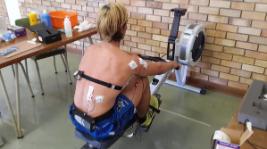
A participant on the Concept 2 rowing ergometer during testing
Dean writes that the purpose of this study was to investigate pacing strategies employed by experienced rowers, thereby elucidating factors pertaining to the regulation of exercise. While pacing strategies are known to be a vital component of athletic competition, the physiological mechanisms concerning the regulation of exercise are widely debated in the literature. By understanding the factors influencing the pacing strategies adopted, training and preparation can be optimised resulting in improved athletic performances.
Understanding pacing strategies to optimise training and potential
After ethical approval was obtained, male participants were recruited from the Rhodes University Rowing Club. Participants then underwent 3 separate trials during which a distance of 2km was covered. During the control trial, participants were accurately informed of the distance to be covered during the trial. The unknown trial required participants to complete 2km however they were not informed of the distance to be covered until it had been completed. The deceptive trial again entailed the participants rowing 2km, however they were incorrectly informed at the start of the trial that only a distance of 1km would be covered. Muscle activity (via EMG), heart rate, RPE, power output and performance time were measured during each trial.
Pacing studies require the use of deception
Dean has completed the data collection and analysis phase of the research and is working on the results, and aims to complete his MSc early in the new year (2016). For more information about this research, contact Dean on g10f2864@campus.ru.ac.za.
Featured Research: Chloë Jager's MSc
Chloë's study (supervised by Andrew Todd) aims to find any relationships that may exist between intrinsic and extrinsic factors, and running-related injury risks in South African long distance runners. Uncovering any relationships of this nature may help to establish possible contributors to improve the chance of preventing injuries, or at least decreasing injury rates, in the future.
Could this research reduce the incidence of running-related injuries?
This topic is important because injuries are highly prevalent in long distance runners and although some contributors to injuries are known, not many studies have investigated the effect of more than one possible factor - in other words, the holistic context of running-related injuries is not known. South African runners are a largely understudied group, and because of the very diverse population it isn't possible to superimpose findings from global studies (for instance, European runners) onto South African runners.
Who could participate in this survey?
- South African citizens of 18 years or older
- Running a minimum of 20 kilometres per week for at least the last 3 months
- Both non-injured and injured runners will be included, as long as the injured runners were running for at least 3 months prior to the injury
- Injured runners must not be out of training for longer than 6 months
On gathering her data, Chloë says "I have targeted all South African long distance runners by sending my questionnaire by email to over 1000 running clubs in South Africa. I then searched for as many South African running clubs on Facebook and posted my questionnaire link and inclusion criteria on those pages. Lastly, I attended races in person with printed out questionnaires and had as many runners as possible fill in my questionnaire."
Over 1000 SA running clubs were approached
As with any research, it hasn't been plain sailing: "A big limitation to my study is that, apart from the runners who filled out my questionnaire in person, most of the data comes from people who can access my questionnaire online - people with internet access. I feel like this has excluded a large number of potential participants in the lower income brackets or poorer living situations. My questionnaire is in English which has also created a barrier to any runners who are either illiterate or do not speak English. Another hurdle I have encountered is people that have taken offense to the questions regarding race and ethnicity. The reason I need to ask these questions is because injury risk has been found to be influenced by genetic predisposition, of which race and ethnicity is a part."
Chloë has completed the data collection part of her research and will now focus on distilling, interpreting and discussing her findings - and hopes to submit her thesis by the end of 2015.
On the relevance of this investigation to every "weekend warrior" and more serious runner in South Africa, Chloë writes, "hopefully, this study will be able to find associations between specific factors and injury risk in long distance runners in SA and from there, this information could inform future studies that could further investigate the extent of these associations. Once these associations are known, it could help runners to adapt their running (if possible) in order to decrease their risk of injuries."
The “additional comments” section for participants has proved really interesting as many of the participants have provided helpful criticism as well as positive feedback. This has provided insight into the “runners’ world” which can be hard to see from a scientist's point of view - when you’re focusing so much on the variables and not the actual participant as a person! This we would do well to remember: although our work is scientific in nature, we should never forget that we are working with real human beings with emotions and opinions, and although it can be challenging to consider these abstract elements, they should never be disregarded!
Never forget we are working with real human beings...
If you would like further information about this particular research topic or would like to read the finished product - please contact Chloë via email: g10j5120@campus.ru.ac.za .
Human KIinetics and Ergonomics at Rhodes has been well represented at local and national conferences recently.
Conference Attendance
European College of Sport Science 2014 (Amsterdam, The Netherlands)
Biokinetics Association's Life Through Movement International Conference 2014 (Stellenbosch, South Africa)
A large group of postgraduates travelled to Stellenbosch in October 2014 to attend and present at the LTMIC.
Rhodes was very proud to have two honours students in the top[ 10 presentations at prize giving, with Travis Steenekamp (supervised by Mr Jonathan Davy) receiving the Gold award, and Ethan Berndt (supervised by Dr Swantje Zschernack) a Silver award.
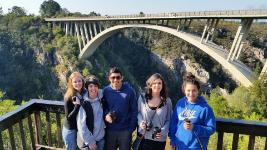
En route: At Storm's River Bridge (L-R) Lara Proud, Stacy Nelleman, Luke Goodenough, Chloe Jager and Gemma Rader enjoy a coffee break
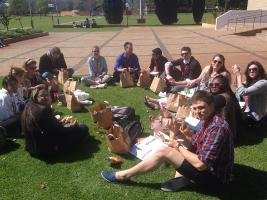
Lunch time at the conference: HKE relaxing in between sessions
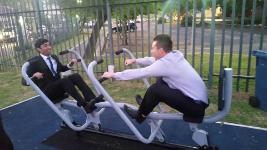
Luke Goodenough and Dusty Zeisberger assess the outdoor gym on Stellenbosch University's residential campus
SA Sports and Recreation Conference 2014 (Potchefstroom, South Africa)
A contingent of postgraduates headed north to Potchefstroom to attend and present at SASReCon 2014.
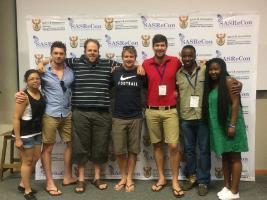
L-R: Simone Haywood, Ethan Berndt, Bennett Ryan, Robert Jones, Justin McDougall, Tendayi Tichiwanhuyi and Zandile Hoyi
Rhodes University Inter-Disciplinary Post-Graduate Conference
Held in Grahamstown, this is an excellent conference for Rhodes students to attend to share their work, and hone their presentation skills. HKE is very proud of Tendayi Tichiwanhuyi who was named best presenter at the conference.

Tendayi (right) is pictured here after winning his prize with fellow HKE MSc scholars Elizabeth Bassey-Duke and Keba Tlhoaele
Last Modified: Wed, 15 Jan 2020 11:54:57 SAST

